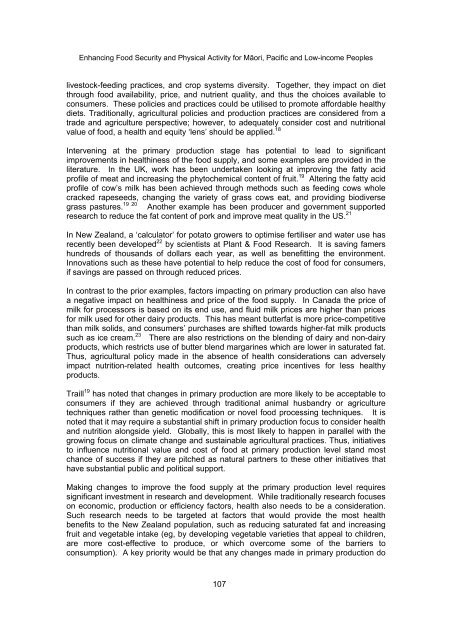enhancing food security and physical activity for maori, pacific and ...
enhancing food security and physical activity for maori, pacific and ...
enhancing food security and physical activity for maori, pacific and ...
- No tags were found...
You also want an ePaper? Increase the reach of your titles
YUMPU automatically turns print PDFs into web optimized ePapers that Google loves.
Enhancing Food Security <strong>and</strong> Physical Activity <strong>for</strong> Māori, Pacific <strong>and</strong> Low-income Peopleslivestock-feeding practices, <strong>and</strong> crop systems diversity. Together, they impact on dietthrough <strong>food</strong> availability, price, <strong>and</strong> nutrient quality, <strong>and</strong> thus the choices available toconsumers. These policies <strong>and</strong> practices could be utilised to promote af<strong>for</strong>dable healthydiets. Traditionally, agricultural policies <strong>and</strong> production practices are considered from atrade <strong>and</strong> agriculture perspective; however, to adequately consider cost <strong>and</strong> nutritionalvalue of <strong>food</strong>, a health <strong>and</strong> equity ‘lens’ should be applied. 18Intervening at the primary production stage has potential to lead to significantimprovements in healthiness of the <strong>food</strong> supply, <strong>and</strong> some examples are provided in theliterature. In the UK, work has been undertaken looking at improving the fatty acidprofile of meat <strong>and</strong> increasing the phytochemical content of fruit. 19 Altering the fatty acidprofile of cow’s milk has been achieved through methods such as feeding cows wholecracked rapeseeds, changing the variety of grass cows eat, <strong>and</strong> providing biodiverse19 20grass pastures. Another example has been producer <strong>and</strong> government supportedresearch to reduce the fat content of pork <strong>and</strong> improve meat quality in the US. 21In New Zeal<strong>and</strong>, a ‘calculator’ <strong>for</strong> potato growers to optimise fertiliser <strong>and</strong> water use hasrecently been developed 22 by scientists at Plant & Food Research. It is saving famershundreds of thous<strong>and</strong>s of dollars each year, as well as benefitting the environment.Innovations such as these have potential to help reduce the cost of <strong>food</strong> <strong>for</strong> consumers,if savings are passed on through reduced prices.In contrast to the prior examples, factors impacting on primary production can also havea negative impact on healthiness <strong>and</strong> price of the <strong>food</strong> supply. In Canada the price ofmilk <strong>for</strong> processors is based on its end use, <strong>and</strong> fluid milk prices are higher than prices<strong>for</strong> milk used <strong>for</strong> other dairy products. This has meant butterfat is more price-competitivethan milk solids, <strong>and</strong> consumers’ purchases are shifted towards higher-fat milk productssuch as ice cream. 23 There are also restrictions on the blending of dairy <strong>and</strong> non-dairyproducts, which restricts use of butter blend margarines which are lower in saturated fat.Thus, agricultural policy made in the absence of health considerations can adverselyimpact nutrition-related health outcomes, creating price incentives <strong>for</strong> less healthyproducts.Traill 19 has noted that changes in primary production are more likely to be acceptable toconsumers if they are achieved through traditional animal husb<strong>and</strong>ry or agriculturetechniques rather than genetic modification or novel <strong>food</strong> processing techniques. It isnoted that it may require a substantial shift in primary production focus to consider health<strong>and</strong> nutrition alongside yield. Globally, this is most likely to happen in parallel with thegrowing focus on climate change <strong>and</strong> sustainable agricultural practices. Thus, initiativesto influence nutritional value <strong>and</strong> cost of <strong>food</strong> at primary production level st<strong>and</strong> mostchance of success if they are pitched as natural partners to these other initiatives thathave substantial public <strong>and</strong> political support.Making changes to improve the <strong>food</strong> supply at the primary production level requiressignificant investment in research <strong>and</strong> development. While traditionally research focuseson economic, production or efficiency factors, health also needs to be a consideration.Such research needs to be targeted at factors that would provide the most healthbenefits to the New Zeal<strong>and</strong> population, such as reducing saturated fat <strong>and</strong> increasingfruit <strong>and</strong> vegetable intake (eg, by developing vegetable varieties that appeal to children,are more cost-effective to produce, or which overcome some of the barriers toconsumption). A key priority would be that any changes made in primary production do107
















